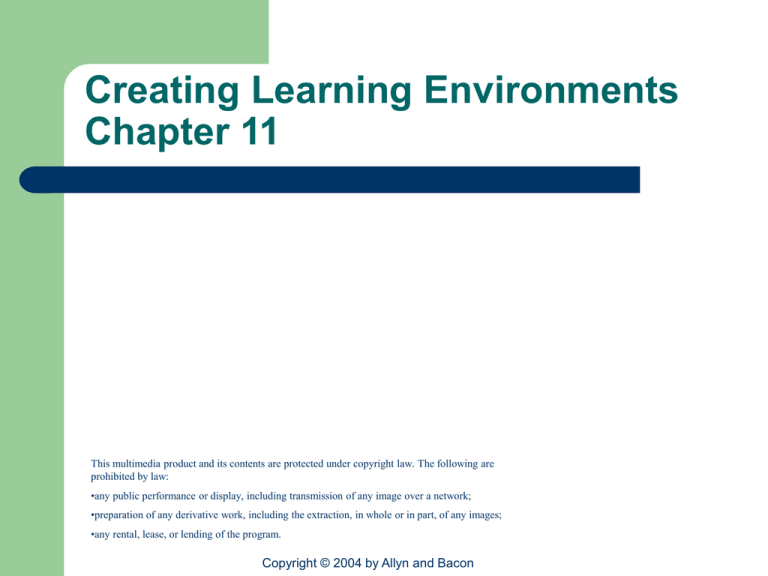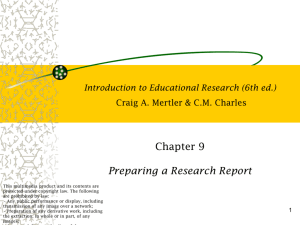Creating Learning Environments Chapter 11
advertisement

Creating Learning Environments Chapter 11 This multimedia product and its contents are protected under copyright law. The following are prohibited by law: •any public performance or display, including transmission of any image over a network; •preparation of any derivative work, including the extraction, in whole or in part, of any images; •any rental, lease, or lending of the program. Copyright © 2004 by Allyn and Bacon Overview The Need for Organization Creating a Positive Learning Environment Maintaining a Good Environment for Learning The Need for Communication Learning Environments for All Students Copyright © 2004 by Allyn and Bacon Concept Map for Chapter 12 The Need for Communication Need for Organization Creating Learning Environments Maintaining a Good Environment for Learning Learning Environments for All Students Copyright © 2004 by Allyn and Bacon Creating a Positive Learning Environment The Need for Organization Characteristics of Classrooms: – – – – – – Multidimensional Simultaneous Immediate Unpredictable Public Histories Copyright © 2004 by Allyn and Bacon Basic Management Task Gain and maintain cooperation Motivate and engage Adjust management to ages of students Copyright © 2004 by Allyn and Bacon Age Related Needs Early elementary: teach rules and procedures Middle elementary: monitor and maintain Late elementary and beginning high school: – – Diplomatically deal with defiance Motivate those immersed in social life Senior high school: – – – Manage curriculum Adapt academics to student needs and interests Teach self-management Copyright © 2004 by Allyn and Bacon Goals for Classroom Management Time for learning – – – Allocated time Engaged time or time on task Academic learning time Access to learning Participation structures Self-management Copyright © 2004 by Allyn and Bacon Where Does the Time Go? Academic Learning Time Engaged Time Actual Academic Time Attended Time Total Time 0 200 400 600 800 1000 1200 Hours Copyright © 2004 by Allyn and Bacon Creating a Positive Learning Environment: Strategies from Research Rules and procedures are required Plan spaces for learning Plan for effective classroom management Get off to a good start Copyright © 2004 by Allyn and Bacon Classroom Procedures Administrative routines Student movement Housekeeping Lesson routines Teacher-student interactions Student-student interactions Copyright © 2004 by Allyn and Bacon Rules for Making Rules Do’s and don’ts Often written down and posted Set the atmosphere Consistent with school rules Consistent with principles of learning Make a few, good rules Copyright © 2004 by Allyn and Bacon Rules for Elementary School Be polite and helpful Respect other’s property Listen when others are speaking Do not hit, shove, or hurt others Obey school rules Copyright © 2004 by Allyn and Bacon Rules for Secondary School Bring required materials to class Seated and ready at the bell Respect and be polite to everyone Respect other people’s property Sit and listen while others speak Obey all school rules Copyright © 2004 by Allyn and Bacon Consequences of Breaking Rules Plan ahead “Bill of Rights” Reasons for appropriate behavior Self-management Penalties Copyright © 2004 by Allyn and Bacon Categories of Penalties Express disappointment Lose privileges Exclude from group Write a reflection Detention Visit the principal’s office Contact parents Copyright © 2004 by Allyn and Bacon Planning Spaces for Learning Interest areas Personal territories Action zone Seating arrangements Copyright © 2004 by Allyn and Bacon Room Arrangements Be aware of the action zone Horizontal rows: whole group presentations Clusters or circle: student interaction Fishbowl or stack: close up demonstrations Copyright © 2004 by Allyn and Bacon Getting Started : Elementary First day well planned and organized Deal with student’s main concerns Teach rules and procedures Whole group focus Appeal to student interests Monitor the whole group Stop misbehavior quickly Copyright © 2004 by Allyn and Bacon Getting Started : Secondary Establish rules, procedures, and standards Clearly communicate standards for work Consistently enforce expectations Monitor students closely Deal with rule infractions quickly Shorter work cycles for lower ability students Monitor student progress carefully Copyright © 2004 by Allyn and Bacon Maintaining a Good Environment for Learning Busy students are better behaved Supervise students closely Include cues for desired behaviors Clear steps for activities Provide necessary materials Engage students in authentic tasks Employ curiosity, interest Copyright © 2004 by Allyn and Bacon Prevention Is the Best Medicine Withitness Overlapping Group focus Movement management Monitor Copyright © 2004 by Allyn and Bacon Dealing with Discipline Problems Make eye contact Verbal hints : name dropping Ask students if they are aware of the consequences of their behavior Remind students of the relative rule or procedure Ask the student to state the correct rule or procedure and follow it Assertively tell the student to stop the misbehavior Offer a choice Copyright © 2004 by Allyn and Bacon Special Problems with Secondary Students Work not completed: – – – – Teach students how to use a daily planner Keep accurate records Enforce established consequences Do not grade on “the benefit of the doubt” Continue to break rules: – – – – Seat student away from other students Catch them before they break the rules Enforce established consequences Don’t accept promises Copyright © 2004 by Allyn and Bacon Special Problems: Hostile Behaviors Get out of the situation as soon as possible Give the student the choice to cooperate Allow a short cool down period Talk privately in the hall Send another student for the assistant principal Conference with a counselor, parents, other teachers Keep a record of the incident Copyright © 2004 by Allyn and Bacon Special Problems: Violence or Destruction of Property Send for help Get the names of all participants Disperse any crowd Do NOT try to break up a fight without help Inform the school office of the incident Follow the school policy Copyright © 2004 by Allyn and Bacon The Need for Communication Message Sent = Message Received? – – – – Hidden messages Body language Choice of words Paraphrase rule Copyright © 2004 by Allyn and Bacon Who’s Problem Is It? Does this affect my role as teacher? Student owned: actively listen Teacher owned: problem solve Copyright © 2004 by Allyn and Bacon Counseling: The Student’s Problem Empathetic listening – Block out external stimuli – Listen carefully – Differentiate between intellectual and emotional messages – Make inferences about the speaker’s feelings Copyright © 2004 by Allyn and Bacon Confrontation and Assertive Discipline Use of “I” messages Passive or hostile responses Care enough to confront Clearly stated expectations with eye contact Do not debate “fairness” of the rules Expect changes, not promises or excuses Copyright © 2004 by Allyn and Bacon Confrontation and Negotiation Teacher imposes a solution Teacher gives in to student demands Gordon’s “no-lose method” – – – – – – Define the problem Generate many possible solutions Evaluate each solution Make a decision on a solution Determine how to implement the solution Evaluate the success of the solution Copyright © 2004 by Allyn and Bacon Student Conflicts and Confrontations Peer harassment Violence – Prevention is the best cure – High academic expectations – Genuine care for students Mentoring, peer mediation, conflict resolution, social skills, relevance, community involvement programs Copyright © 2004 by Allyn and Bacon




